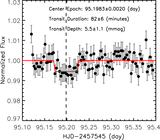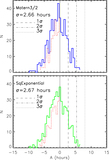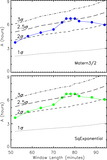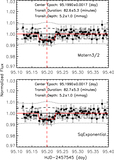Image Details

Caption: Figure 7.
Simulations of TTVs of Proxima Centauri b due to an outer planet. Left panel: TTVs due to an outer planet with various masses and periods. The gray solid lines from top to bottom represent TTV = 30, 10, 1, 0.1 minutes, respectively. In these simulations, we assume a coplanar orbital configuration of the two planets, where the eccentricity of Proxima Centauri b is set to e = 0.1 and the outer planet is in a circular orbit. The black dashed line is a non-coplanar (i.e., inclination = 30°) model, producing TTV = 30 minutes. The red dotted lines represent reflex stellar RV amplitudes induced by the outer planet. Note that any planet with RV amplitude >3 m s−1 can be ruled out by the RV observation of Anglada-Escudé et al. (2016). Right panel: eight arbitrary TTV models fit to the misalignment of the transit epochs observed by MOST and BSST. In these models, the outer planet is in a coplanar near 2:1 mean motion resonance orbit with Proxima Centauri b, and its period is set to 22.58509 days arbitrarily. The curves with different colors represent best-fitted models for different designated eccentricities of Proxima Centauri b, varying from e = 0 to e = 0.35 in a step sizes of 0.05. The best-fitted masses of the outer planet are listed in the legend.
Copyright and Terms & Conditions
© 2017. The American Astronomical Society. All rights reserved.










